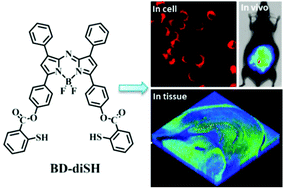当前位置:
X-MOL 学术
›
Biomater. Sci.
›
论文详情
Our official English website, www.x-mol.net, welcomes your
feedback! (Note: you will need to create a separate account there.)
A near-infrared fluorescent probe for sensitive detection and imaging of sulfane sulfur in living cells and in vivo†
Biomaterials Science ( IF 5.8 ) Pub Date : 2018-01-30 00:00:00 , DOI: 10.1039/c7bm00951h Xiaoyue Han 1, 2, 3, 4, 5 , Xinyu Song 1, 2, 3, 4, 5 , Bowei Li 1, 2, 3, 4, 5 , Fabiao Yu 1, 2, 3, 4, 5 , Lingxin Chen 1, 2, 3, 4, 5
Biomaterials Science ( IF 5.8 ) Pub Date : 2018-01-30 00:00:00 , DOI: 10.1039/c7bm00951h Xiaoyue Han 1, 2, 3, 4, 5 , Xinyu Song 1, 2, 3, 4, 5 , Bowei Li 1, 2, 3, 4, 5 , Fabiao Yu 1, 2, 3, 4, 5 , Lingxin Chen 1, 2, 3, 4, 5
Affiliation

|
Sulfane sulfur refers to ionized sulfur that is reversibly attached to other sulfur atoms in the form of 6-valence electrons (S0). Sulfane sulfur possesses stronger nucleophilicity and reducibility than hydrogen sulfide in a series of physiological reactions, which probably makes sulfane sulfur the actual signal molecule in cells. Herein, we designed and synthesized a near-infrared (NIR) fluorescent probe BD-diSH for sensitive detection and imaging of sulfane sulfur in living cells and in vivo. The probe BD-diSH is composed of two moieties: the fluorophore azo-BODIPY and the sulfane sulfur recognition unit, viz., 2-mercapto benzoate. BD-diSH displayed high sensitivity and selectivity towards sulfane sulfur. The mercapto group (–SH) of 2-mercapto benzoic acid can nucleophilically capture the sulfur atom of thiosulfoxide tautomers in sulfane sulfur to form –SSH. The group –SSH will immediately induce intramolecular cyclization reaction and release the azo-BODIPY fluorophore to emit NIR fluorescence. The probe BD-diSH was successfully applied to detect and image sulfane sulfur in the cytoplasm of the living cells. The results illustrated that the endogenous and exogenous sulfane sulfur level changed depending on different cell lines. BD-diSH was also capable of imaging the level changes of sulfane sulfur in mice. The above applications make our new probe a potential chemical tool for the study of physiological and pathological functions of sulfur sulfide in living cells and in vivo.
中文翻译:

一种近红外荧光探针,用于灵敏检测和成像活细胞和体内的亚砜硫†
硫磺硫是指以6价电子(S 0)形式可逆地连接到其他硫原子上的离子化硫。在一系列生理反应中,硫磺比硫化氢具有更强的亲核性和还原性,这很可能使硫磺成为细胞中真正的信号分子。在这里,我们设计和合成了一种近红外(NIR)荧光探针BD-diSH,用于灵敏检测和成像活细胞和体内的硫磺。探针BD-diSH由两个部分组成:偶氮荧光团-BODIPY和硫磺硫识别单元,即。,2-巯基苯甲酸酯。BD-diSH显示出对硫磺硫的高灵敏度和选择性。2-巯基苯甲酸的巯基(–SH)可以亲核捕获硫磺中硫代亚砜互变异构体的硫原子,形成–SSH。–SSH组将立即引起分子内环化反应并释放偶氮-BODIPY荧光团发出NIR荧光。探针BD-diSH已成功用于检测和成像活细胞细胞质中的亚砜硫。结果表明,内源性和外源性硫磺硫水平随细胞系的不同而变化。BD-diSH还能够对小鼠中硫磺水平的变化进行成像。上述应用使我们的新探针成为研究硫化物在活细胞和体内的生理和病理功能的潜在化学工具。
更新日期:2018-01-30
中文翻译:

一种近红外荧光探针,用于灵敏检测和成像活细胞和体内的亚砜硫†
硫磺硫是指以6价电子(S 0)形式可逆地连接到其他硫原子上的离子化硫。在一系列生理反应中,硫磺比硫化氢具有更强的亲核性和还原性,这很可能使硫磺成为细胞中真正的信号分子。在这里,我们设计和合成了一种近红外(NIR)荧光探针BD-diSH,用于灵敏检测和成像活细胞和体内的硫磺。探针BD-diSH由两个部分组成:偶氮荧光团-BODIPY和硫磺硫识别单元,即。,2-巯基苯甲酸酯。BD-diSH显示出对硫磺硫的高灵敏度和选择性。2-巯基苯甲酸的巯基(–SH)可以亲核捕获硫磺中硫代亚砜互变异构体的硫原子,形成–SSH。–SSH组将立即引起分子内环化反应并释放偶氮-BODIPY荧光团发出NIR荧光。探针BD-diSH已成功用于检测和成像活细胞细胞质中的亚砜硫。结果表明,内源性和外源性硫磺硫水平随细胞系的不同而变化。BD-diSH还能够对小鼠中硫磺水平的变化进行成像。上述应用使我们的新探针成为研究硫化物在活细胞和体内的生理和病理功能的潜在化学工具。











































 京公网安备 11010802027423号
京公网安备 11010802027423号